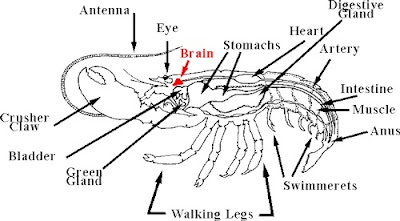Wait, they do what?! Yup! It’s true! So what’s the deal? To
start, animals need to communicate with others for lots of reasons. It could be
to send an alarm, find a mate or defend a territory. Lobsters are no different.
And in the ocean, chemicals, called pheromones, are an important communication
method. These chemicals travel through the water, potentially impacting the behavior
of another animal. If you’re a lobster hunkered down in your own cave, you need
to communicate with other lobsters walking by. That’s where pee comes in!
 |
| Internal anatomy...find the bladder by the eyes (Gulf of Maine Research Institute) |
A lobster’s bladder is located under their brain. Pheromones
are created, added to the urine and then released from nephropores at the base
of their antennae. And that urine stream can go far…up to seven feet away from
the lobster. That’s some pretty powerful pee propulsion! But what is that urine
“saying” to other lobsters? The pheromones are used mostly for love…and war.
 |
| Adult lobster looking for a place to hang out |
 |
| This juvenile lobster found Home Sweet Shell |
Lobsters face towards the entrance of their cave, making it easy to defend the home-front from other lobsters, with males asserting their dominance over neighboring lobsters. Peeing out of their heads is the most direct way for urine to travel out of their home into the surrounding water. If two males find themselves in the same area, one lobster is determined to be the strongest and may depend on the amount of pheromone in the urine stream. This gives him a competitive edge for the best shelter and preferential mating rights.
 |
| Lobster condos provides enough space for everyone! |
Once the battle has been won, it’s now time to impress the
ladies. A dominant male lobster will have a more attractive scent to female
lobsters, indicating that he’s a good choice for a mate. Picking up on that
scent, a female lobster cautiously approaches the male’s burrow and urinates
towards him! This reduces his aggression, allowing the female to enter his cave
for mating. And because she wants the male all to herself, the female will use more
urine to tell other females walking by that the male lobster is “unavailable”
at the current moment.
So there you have it…your fun fact for any gathering of
family or friends. Need some more information on lobsters or want to take a
trip to see lobsters in person? Head to the Aquarium and see a 12-pound lobster
in our Gulf of Maine boulder reef exhibit or the 6-month old lobsters in our lobster
nursery in the Blue Planet Action Center.
 |
| Lobsters helping us to learn about shell rot |
More importantly, learn how Aquarium researchers study shell rot, a disease that’s impacting lobsters throughout New England, and work with lobster fishers to ensure healthy lobster populations for generations to come. And you never know…you may find your new fun fact while you’re here!


